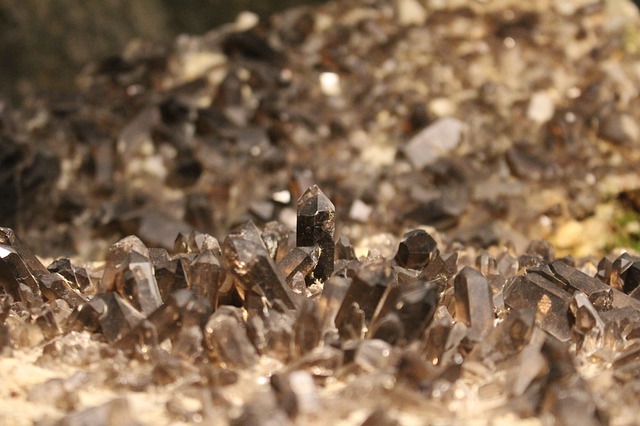Smoky Quartz – Overview

You may be aware of the white, yellowish, rose, and purple amethyst varieties of quartz. But did you know that there is brownish-grey crystalline quartz which is known as smoky quartz?
Smoky quartz is a colored variety of quartz crystal that ranges from yellowish-brown to greyish-brown colors. Some of the specimens may appear so dark that they look black.
Similar to other quartz crystals, smoky quartz is a silicon dioxide crystal, but it gets its color from the additional silicone that’s formed by the dioxide (a dioxide is the result of two atoms of oxygen in its molecule) due to the natural radiation process taking place from the surrounding rocks underneath the Earth’s surface.
Smoky quartz is an abundant gem material found in several locations around the world, and hence, it is a relatively inexpensive gemstone. You can find large amounts of these crystals with excellent transparency due to very few inclusions. Moreover, another reason for its relatively low price is the color which does not have a high demand. The greyish brown specimens are considered less desirable; however, when the stone is cut, quartz crystals with a reddish-brown or orange hue are the usually preferred gemstones.
Where is it Found?
Smoky quartz is an abundantly found gem material that you can find in several parts of the world, but if you look at the geological occurrence of the stone, it is mainly found in quartz veins and extreme igneous rocks that are formed during the later stages of magma’s crystallization. Because of this extremity, you can find the formation of exceptionally large crystals.
With that said, smoky quartz is the national gem of Scotland. There, it goes by the name “cairngorm” after the Cairngorm Mountains, located in Scotland’s eastern Highlands. Also, this mineral has been found near Pike’s Peak, Colorado.
You can also find smoky quartz that is formed at lower temperatures in the fractures of metamorphic and sedimentary rocks. The radioactive mineral found in the surrounding rocks plays an integral role in how the gemstone gets its color. The irradiation leads to the very dark shades of smoky quartz; hence, the darker specimens of smoky quartz come from locations with higher radioactive mineral content.
Currently, the smoky quartz crystal comes from several sources around the world. Brazil is considered the largest supplier of gemstone material that is used in jewelry making. Another major supplier of smoky quartz is Madagascar which it produces in commercial quantities.
Smoky quartz can also be found at several other locations, including Switzerland, Scotland, Russia, and Ukraine. You can also find it in some parts of the U.S., including Colorado, North Carolina, and Maine. It is the national gemstone of Scotland where it is known as “cairngorm.” Additionally, the darker variety of this mineral is known as “morion” in Scotland.
Physical Properties of Smoky Quartz

This mineral has very similar physical properties as other color variants of quartz crystals. Like its cousins, the chemical classification is silicate, and it ranges from yellowish-brown to orange-brown and greyish brown in color. With a vitreous luster, the crystal has a hardness of 7 on the Mohs’ scale of hardness and a specific gravity ranging between 2.6 and 2.7.
The color is heat sensitive, and the crystal is likely to change its color when exposed to temperatures between 200 and 300 oC. Moreover, prolonged exposure to UV light can result in a loss of color. However, the color can be relapsed by irradiation of the crystals.
The Uses of Smoky Quartz
Perhaps the most common use of this particular type of quartz is the gemstone industry. The minerals are refined and cut as gems and are then used to enhance the aesthetic appeal of rings, earrings, necklaces, and brooches. Given that smoky quartz can range from yellowish-brown to orange-brown and a less desirable greyish brown, it can cater to the demands of various individuals.
The gemstone is used in jewelry making for women and can also be used by men to enhance the appeal of their rings and cufflinks. While the trend is not quite common today, the use of smoky quartz to enhance the appeal of men’s jewelry was quite common during the Victorian Era, where the dark brownstones extracted from the Mourne Mountains of Ireland were often used in jewelry, especially mourning jewelry.
During the early days of the 12th century, the gemstone was used in several parts of the world, including China, to make eyeglasses. These glasses were also used as a shield against UV sunlight and other sources of bright light. Some of the glasses and shields were worn during court proceedings as the darker-toned material was used to hide the facial expressions of the judges.
Apart from jewelry and glasses, smoky quartz is also used as a carving material. Since the gemstone has a relatively lower price and one can easily find large pieces of smoky quartz, it is one of the best choices of gem material that can be used for carving.
Treatments
As mentioned earlier, the color of these quartz crystals can range from yellowish-brown to orange-brown and even darker shades of greyish brown. However, the gem material may lose its color when exposed to UV light and higher temperatures.
The color of the smoky quartz may be changed in a lab setting by exposure to higher temperatures. It is a particularly common treatment for dark-colored smokey quartz crystals. However, the stone is seldom treated to revert its color once it loses its darker shade. In addition, it is not synthetically produced in the lab because the mineral is readily available and has a relatively lower demand and price.
Final Words
Smoky quartz is a color variant of the quartz family that shares similar physical properties. However, it has a unique color range that makes it appropriate for use as a gemstone. Moreover, its physical properties, such as hardness and specific gravity, make it suitable for carving.
